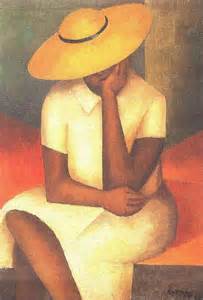Guest post written by Dr. Britine Perkins, PhD.

I was given the opportunity to preview the new Amon Carter Museum’s Norman Lewis exhibit before it opened to the public. This was indeed a special opportunity as the ACM is only the 2nd museum nationwide to host this breathtaking exhibit. Because Lewis’s work is about movement, the pieces are grouped to showcase how his art evolved from figurative in the 1920’s and 30’s, to completely abstract expressionist by the 1940’s. He is one of a very few African-American artists to pursue this style of painting.

When one thinks of abstract expressionist artists from the 1930’s to the 1960’s, immediately names like Jackson Pollock , Picasso, de Kooning, Max Ernst, and one of my personal favorites, Frank Stella, among many others will come to mind. Unfortunately, what does not come to mind are African-American abstract expressionist artists, which was usually considered a rare departure for an African American artist (at one meeting in Italy that featured the likes of Polluck and de Kooning, Lewis was the only African American in the room, much like this preview where I was only one of two minorities in the room). For Norman Lewis, who was born in 1909 in Harlem, expressing the energy of the Renaissance unfolding around him profoundly influenced his work. Early on in his career, he realized that he wanted to paint the Black experience, just not in the figurative way that was expected on African American artists of that time. By the 1940’s, he had rejected painting figurative works, and painting what he wanted to paint. Because he was African American he was not truly accepted by the white abstract expressionist artists, nor was he accepted by African American artists who felt the only way to express Black life was through figurative art.
Although considered a successful artist (his work was exhibited in over 130 exhibitions in his lifetime) he did not receive the true recognition as an abstract expressionist artist till after his death, something he has always predicted. Regardless, he continued to paint the way he wanted: American life is diverse and so should the art that depicts it, a struggle that Norman Lewis is definitely winning, even if posthumously. Today many of his pieces are being sold for between $250,000 and $350,000, while during his lifetime, most sold for less than $20,000 as noted in a recent March 2016 CBS Sunday Morning clip (Reappraising the art of Normal Lewis) about his long overdue rightful recognition as an abstract expressionist artist.
After viewing just some of his extraordinary works, one leaves with an overwhelming admiration for a man who fought racism on both sides and yet continued to do what he wanted to do. Although he was overlooked in his lifetime, I for one am very glad to see him finally get his due as not just an African-American artist, but one of this nation’s greatest abstract expressionist artists.
The Procession: The Art of Norman Lewis will be om diplay until August 21, 2016. To find out more about this wonderful exhibition and all of the other things click Amon Carter American Museum of Art.
Remember “thisisyourbestyear”, enjoy great works of art.








2 Comments
The Smiling Pilgrim
July 2, 2016 at 4:44 pmWow these are some amazing pieces!
thisisyourbestyear
July 2, 2016 at 6:53 pmThey are just fascinating. Thanks for reading, and remember “thisisyourbestyear”. M. Johns